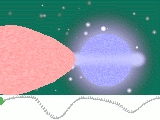
Beta Lyrae
Encyclopedia
Beta Lyrae is a binary star system approximately 882 light-year
s away in the constellation
Lyra
. Beta Lyrae has the traditional name Sheliak (occasionally Shelyak), from الشلياق šiliyāq, the Arabic name of the constellation Lyra.
Beta Lyrae is an eclipsing semi-detached binary system made up of a B7II primary star and a secondary that is probably also a B-type star. The brighter, less massive star (B7II) in the system has filled its Roche lobe
and is undergoing mass transfer with the other star due to its evolutionary state. The secondary, more massive star has an accretion disk due to this mass transfer. This accretion disk blocks our view of the secondary star, making it difficult for astronomers to pinpoint what its stellar type is. The system also contains bipolar jets.
Beta Lyrae changes its apparent magnitude
from +3.4 to +4.6 over a period of 12.9075 days. The two components of the main star are so close together that they cannot be resolved with optical telescopes, forming a spectroscopic binary.
Two other stars appear close to the line of sight of Beta Lyrae, but are not part of the binary system. One, at an angular distance of 45.7", is of spectral type B7V, has an apparent magnitude of +7.2, and can easily be seen with binoculars. It is about 80 times as luminous as the Sun and is also a spectroscopic binary with a period of 4.34 days. The other, Beta Lyrae F, is magnitude 9.9v separation 86" and with a luminosity 7 times that of the Sun.
Light-year
A light-year, also light year or lightyear is a unit of length, equal to just under 10 trillion kilometres...
s away in the constellation
Constellation
In modern astronomy, a constellation is an internationally defined area of the celestial sphere. These areas are grouped around asterisms, patterns formed by prominent stars within apparent proximity to one another on Earth's night sky....
Lyra
Lyra
Lyra is a small constellation. It is one of the 48 constellations listed by the 2nd century astronomer Ptolemy, and remains one of the 88 modern constellations recognized by the International Astronomical Union. Its principal star, Vega — a corner of the Summer Triangle — is one of the brightest...
. Beta Lyrae has the traditional name Sheliak (occasionally Shelyak), from الشلياق šiliyāq, the Arabic name of the constellation Lyra.
Beta Lyrae is an eclipsing semi-detached binary system made up of a B7II primary star and a secondary that is probably also a B-type star. The brighter, less massive star (B7II) in the system has filled its Roche lobe
Roche lobe
The Roche lobe is the region of space around a star in a binary system within which orbiting material is gravitationally bound to that star. If the star expands past its Roche lobe, then the material can escape the gravitational pull of the star. If the star is in a binary system then the material...
and is undergoing mass transfer with the other star due to its evolutionary state. The secondary, more massive star has an accretion disk due to this mass transfer. This accretion disk blocks our view of the secondary star, making it difficult for astronomers to pinpoint what its stellar type is. The system also contains bipolar jets.
Beta Lyrae changes its apparent magnitude
Apparent magnitude
The apparent magnitude of a celestial body is a measure of its brightness as seen by an observer on Earth, adjusted to the value it would have in the absence of the atmosphere...
from +3.4 to +4.6 over a period of 12.9075 days. The two components of the main star are so close together that they cannot be resolved with optical telescopes, forming a spectroscopic binary.
Two other stars appear close to the line of sight of Beta Lyrae, but are not part of the binary system. One, at an angular distance of 45.7", is of spectral type B7V, has an apparent magnitude of +7.2, and can easily be seen with binoculars. It is about 80 times as luminous as the Sun and is also a spectroscopic binary with a period of 4.34 days. The other, Beta Lyrae F, is magnitude 9.9v separation 86" and with a luminosity 7 times that of the Sun.
See also
- Beta Lyrae in fiction
- 29 Canis Majoris29 Canis Majoris29 Canis Majoris is a star in the constellation Canis Major.29 Canis Majoris is an O-type blue supergiant with a mean apparent magnitude of +4.88. It is approximately 3000 light years from Earth. It is classified as a Beta Lyrae type variable star and its brightness varies from magnitude +4.84...
- Pi ScorpiiPi ScorpiiPi Scorpii is a triple star system in the constellation Scorpius. It is approximately 459 light years from Earth.Pi Scorpii A is a contact binary of the Beta Lyrae type. Both its members are hot, blue-white B-type dwarfs. Together they have a mean apparent magnitude of +2.89. Their rotation...
- Ring NebulaRing NebulaThe famously named "Ring Nebula" appears in the northern constellation of Lyra and is located in the Carina–Sagittarius Arm...
- VegaVegaVega is the brightest star in the constellation Lyra, the fifth brightest star in the night sky and the second brightest star in the northern celestial hemisphere, after Arcturus...
- Zeta AndromedaeZeta AndromedaeZeta Andromedae is a star system in the constellation Andromeda. It is approximately 181 light years from Earth....

